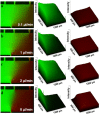Generating 2-dimensional concentration gradients of biomolecules using a simple microfluidic design
- PMID: 28852431
- PMCID: PMC5552394
- DOI: 10.1063/1.4991550
Generating 2-dimensional concentration gradients of biomolecules using a simple microfluidic design
Abstract
This study reports a microfluidic device for generating 2-dimensional concentration gradients of biomolecules along the width and length of a chamber and conventional 1-dimensional gradients along the width of its lateral parallel channels. The gradient profile can be precisely controlled by the applied flow rate. The proposed design is simple and straightforward, has a small footprint size compared to previously reported devices such as tree-shape designs, and for the first time, provides capability of generating desired 2D and 1D gradients, simultaneously. The finite element simulation analysis proves the feasibility of the microfluidic device, and the fluorescently labelled IgG antibody is used to demonstrate generated chemical gradients. This simple microfluidic device can be implemented for a wide range of high-throughput concentration gradient applications such as chemotaxis, drug screening, and organs-on-chips.
Figures




Similar articles
-
Generating multiplex gradients of biomolecules for controlling cellular adhesion in parallel microfluidic channels.Lab Chip. 2012 Nov 7;12(21):4363-71. doi: 10.1039/c2lc40233e. Lab Chip. 2012. PMID: 22907392
-
Generation of stable complex gradients across two-dimensional surfaces and three-dimensional gels.Langmuir. 2007 Oct 23;23(22):10910-2. doi: 10.1021/la7026835. Epub 2007 Oct 2. Langmuir. 2007. PMID: 17910490
-
Generation of Gradients on a Microfluidic Device: Toward a High-Throughput Investigation of Spermatozoa Chemotaxis.PLoS One. 2015 Nov 10;10(11):e0142555. doi: 10.1371/journal.pone.0142555. eCollection 2015. PLoS One. 2015. PMID: 26555941 Free PMC article.
-
Spatial manipulation with microfluidics.Front Bioeng Biotechnol. 2015 Apr 8;3:39. doi: 10.3389/fbioe.2015.00039. eCollection 2015. Front Bioeng Biotechnol. 2015. PMID: 25905100 Free PMC article. Review.
-
Surface-Bound Molecular Gradients for the High-Throughput Screening of Cell Responses.Front Bioeng Biotechnol. 2015 Aug 31;3:132. doi: 10.3389/fbioe.2015.00132. eCollection 2015. Front Bioeng Biotechnol. 2015. PMID: 26380260 Free PMC article. Review.
Cited by
-
Self-Cleaning Ceramic Tiles Produced via Stable Coating of TiO₂ Nanoparticles.Materials (Basel). 2018 Jun 13;11(6):1003. doi: 10.3390/ma11061003. Materials (Basel). 2018. PMID: 29899252 Free PMC article.
-
Organ-on-a-Chip: Ubi sumus? Fundamentals and Design Aspects.Pharmaceutics. 2024 May 2;16(5):615. doi: 10.3390/pharmaceutics16050615. Pharmaceutics. 2024. PMID: 38794277 Free PMC article.
-
The Fabrication and Bonding of Thermoplastic Microfluidics: A Review.Materials (Basel). 2022 Sep 18;15(18):6478. doi: 10.3390/ma15186478. Materials (Basel). 2022. PMID: 36143790 Free PMC article. Review.
References
LinkOut - more resources
Full Text Sources
Other Literature Sources
